Eggplant is one of our favorite vegetables here at Foolproof Living, as this nutrient-dense purple veggie is versatile, inexpensive, and easy to cook. If you’re looking for no-fuss, healthy eggplant recipes, we have no shortage on the blog. There are many different ways to prepare eggplant side dishes, such as Charring Eggplant on Stove, Roasting Eggplant Whole, or making Roasted Eggplant Slices and Roasted Eggplant Halves. For a super quick-cooking option, also try my Air Fried Eggplant!
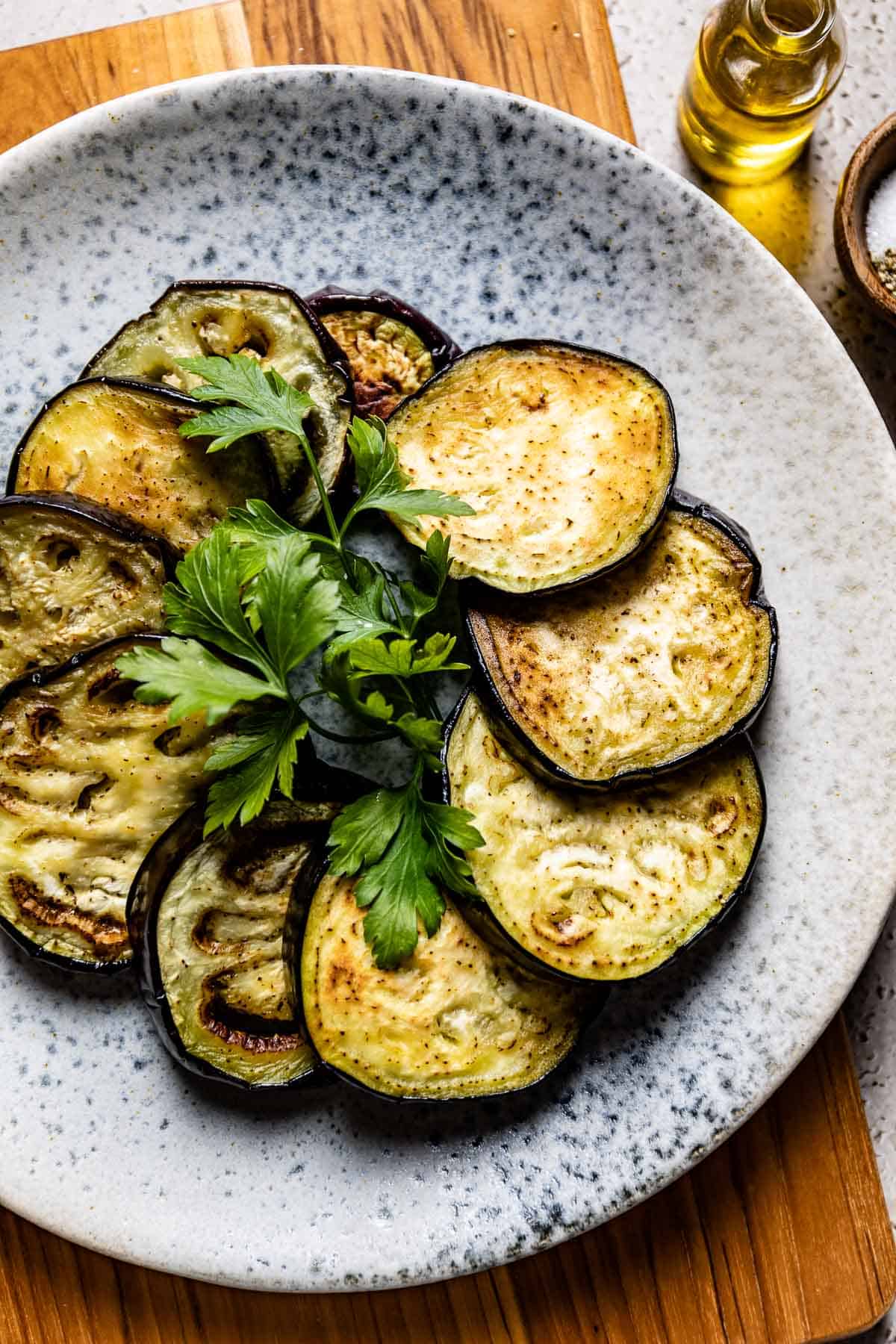
Ingredients
Eggplant caramelizes beautifully with a bit of oil, so all you need for this recipe for pan-fried eggplant are salt, pepper, and garlic to enhance the veggie’s mild, sweet flavor. Below, you’ll find more information about these simple ingredients:
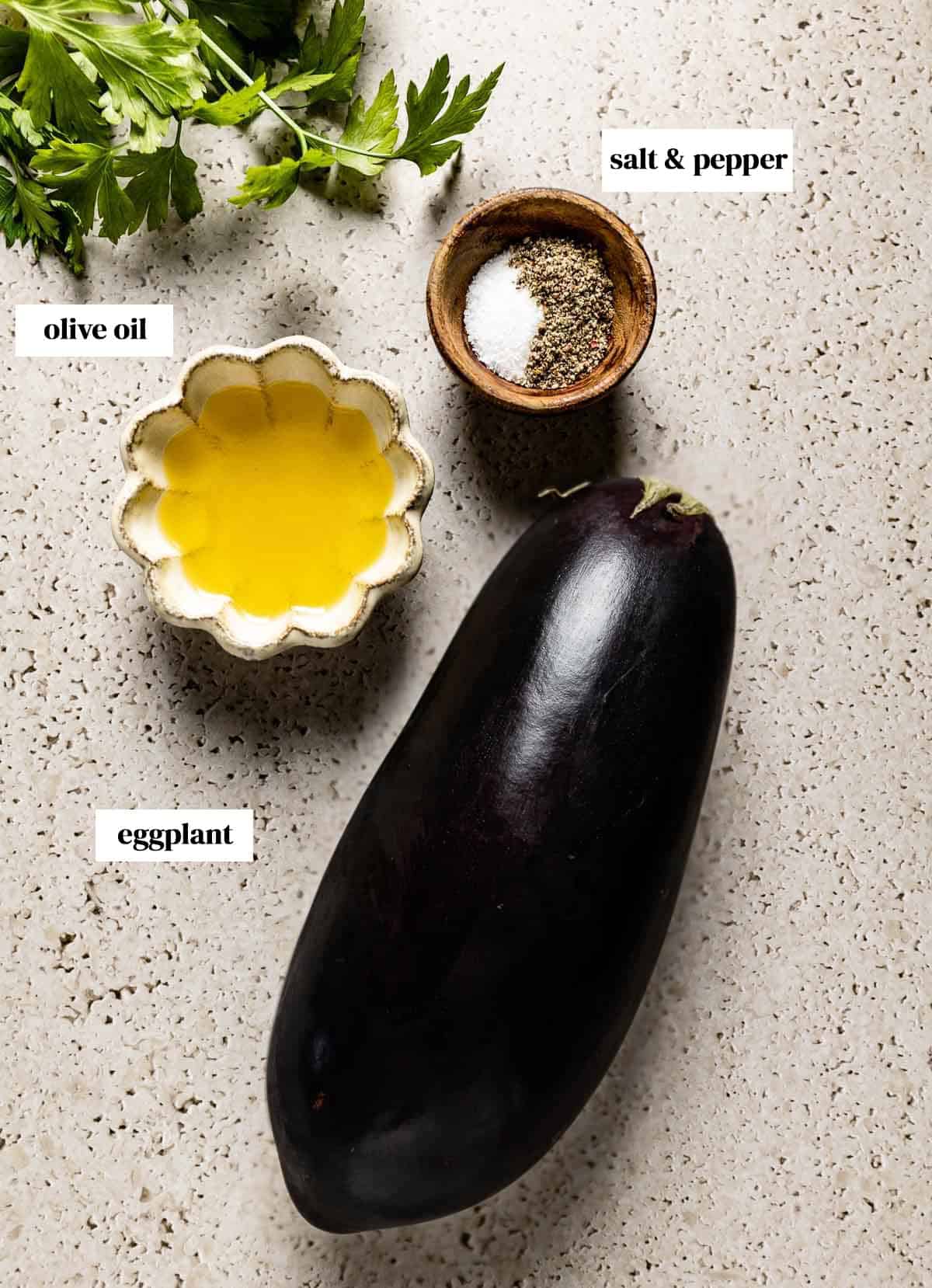
- Fresh Eggplants: We chose to use globe eggplant for this eggplant saute recipe, which is the most widely available in the US. You’ll recognize this type of eggplant as one with shiny skin, a deep purple color, and a rounded shape. However, different varieties of eggplant will also work for this recipe, such as Japanese Eggplant, Chinese Eggplant, or Italian Eggplant. You can even make sautéed White Eggplant!
- Extra virgin olive oil: Caramelized eggplant recipes often call for olive oil, and I also prefer frying eggplant in olive oil. However, feel free to use any type of vegetable oil or even butter for this recipe.
- Fresh garlic cloves: I love the aroma of stir-fried eggplant with garlic. If you’re in a pinch, you can also make sautéed eggplant with garlic powder.
- Seasonings: We’re keeping the seasonings simple for this recipe. You’ll need kosher salt, ground black pepper, and red pepper flakes (optional).
Optional Add-Ins & Variations
While the ingredient list for this simple eggplant recipe is short and sweet, feel free to amp up the flavor of your eggplant side dish by adding toppings and seasonings of your choice. Here are a few suggestions:
- Parmesan cheese: Garlic parmesan eggplant is an Italian favorite! Feel free to top your eggplant liberally with parmesan cheese for a nutty taste that pairs beautifully with the caramelized flavor notes. You can also top it with feta cheese for a Mediterranean flair. Both options would pair well with grilled chicken or fish.
- Fresh herbs: A sprinkle of fresh herbs, such as fresh parsley or fresh basil leaves, will elevate your pan seared eggplant and add a hint of earthy flavor.
- Asian variation: You can easily turn this easy recipe for eggplant saute into an Asian eggplant stir fry, filled with yummy umami flavor, with just a few ingredient swaps. Fry the eggplant in sesame oil and replace the salt with 2 tablespoons of soy sauce. Finish it off with a few sesame seeds and some fresh cilantro.
- Sauteed eggplant with onion and garlic: If you have an onion lying around, feel free to dice it and saute it alongside your eggplant for extra aromatics. Sauteed eggplant and onions would pair well with virtually any main dish!
How to Cut Eggplant for Pan Frying?
I chose to cut my eggplant into rounds (slices) for this pan fried eggplant recipe, as I find this to be the quickest and easiest way to prepare it for cooking. Eggplant rounds are also easy to flip, caramelize well, and maintain a soft texture instead of becoming mushy. This method is also ideal if you’re serving your eggplant as a side.
If you plan to use your pan cooked eggplant in a recipe, you may need to dice it instead. Just be aware that sauteed eggplant cubes don’t caramelize as well, so handle them gently. Additionally, in order to prevent them from getting mushy, you would want to be gentle as you flip them.
Follow the instructions below to prepare your eggplant for sauteing. For more detailed instructions, visit my easy guide on How to Cut Eggplant.
- Slices: Rinse the eggplant in cold water and dry it off with a paper towel. Trim the stem end of the eggplant and spin it around to cut off a small part of the bottom. Lay the eggplant on its side and slice it into ½-inch thick rounds.
- Diced: Trim the eggplant on both ends. Lay the eggplant on its side or stand it up vertically (whichever is more comfortable) and slice it into ½-inch lengthwise slices. Stack the slices on top of one another and cut them vertically into ½ inch sticks. Rotate the sticks 90 degrees and cut ½ inch slices widthwise. You can also cut it into 1-inch cubes, depending on your recipe.
How to Cook Eggplant on Stove Top
This easy eggplant recipe takes only about 15 minutes and requires only one skillet. Whether you cook your eggplant in slices or cubes, remember to leave them alone while cooking and only flip them once to ensure they take on that beautiful, golden brown color. Below is step by step instructions on how to saute eggplant:
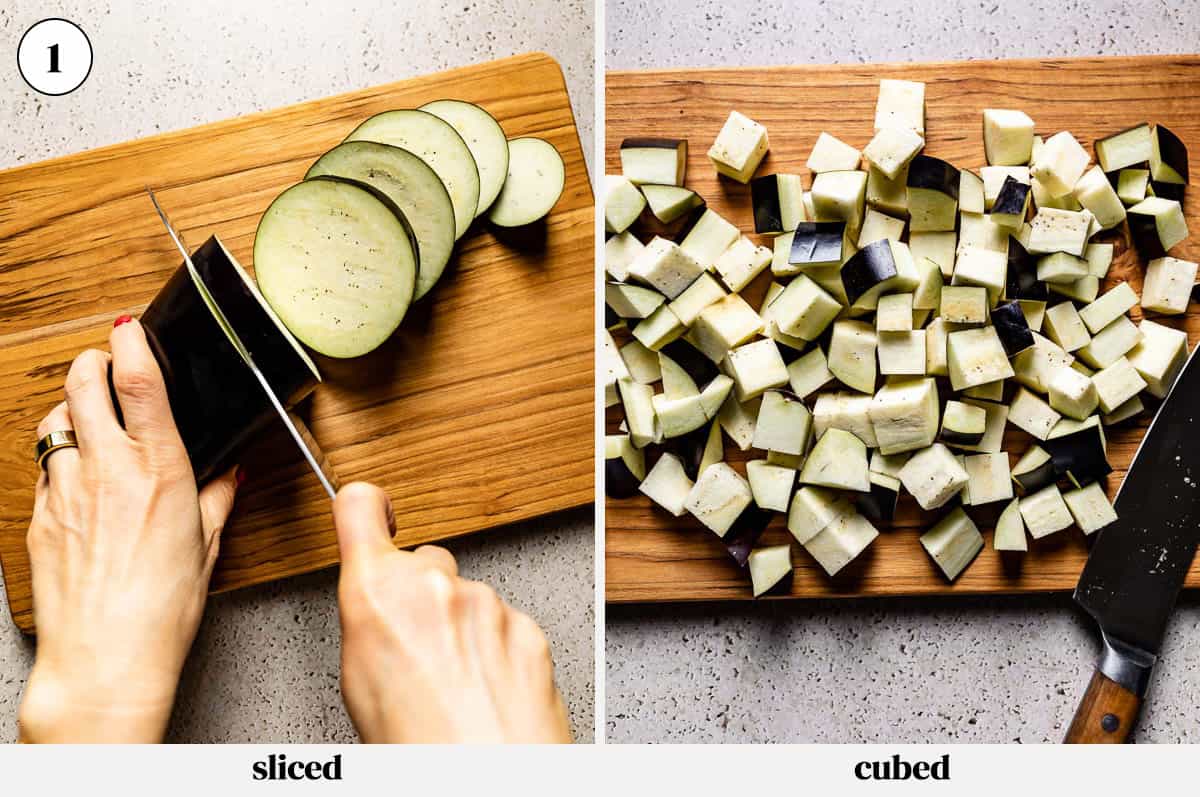
- Slice the eggplant: Cut the eggplant into ½-inch thick rounds. Alternatively, you can also dice your eggplant.
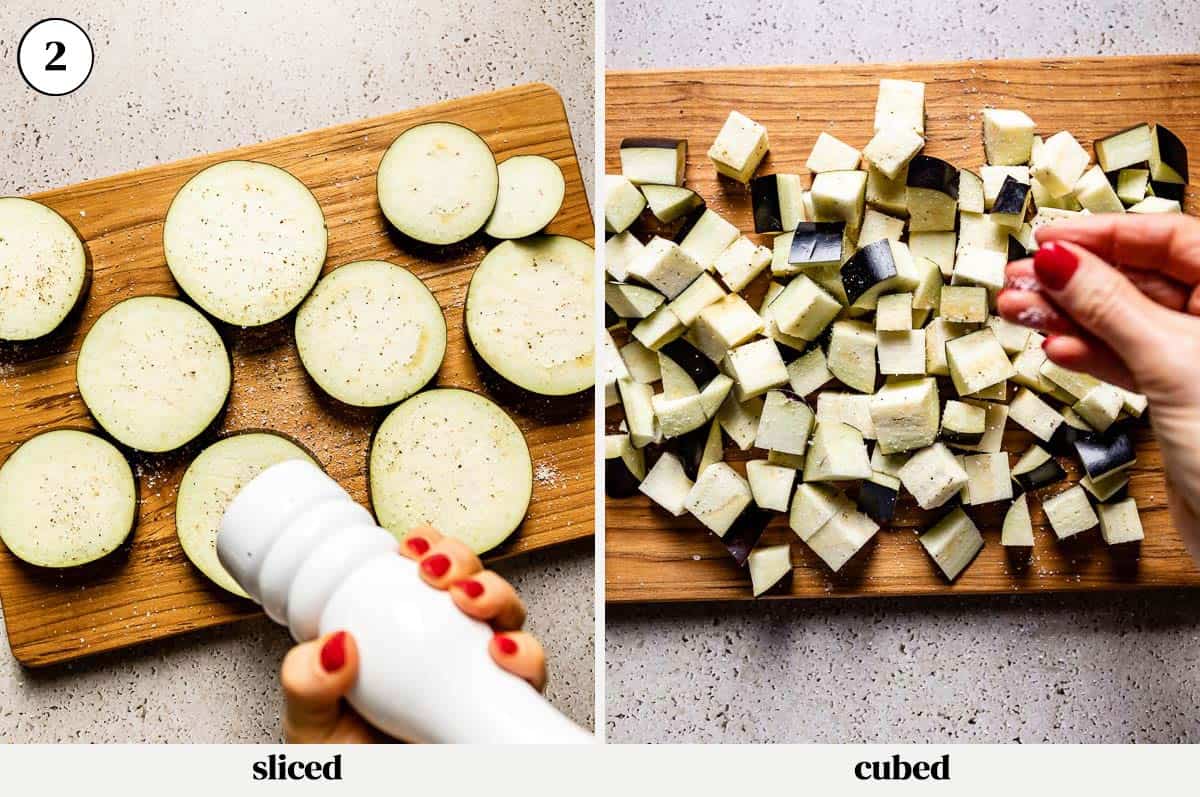
- Season: Season the eggplant on both sides with salt and pepper.
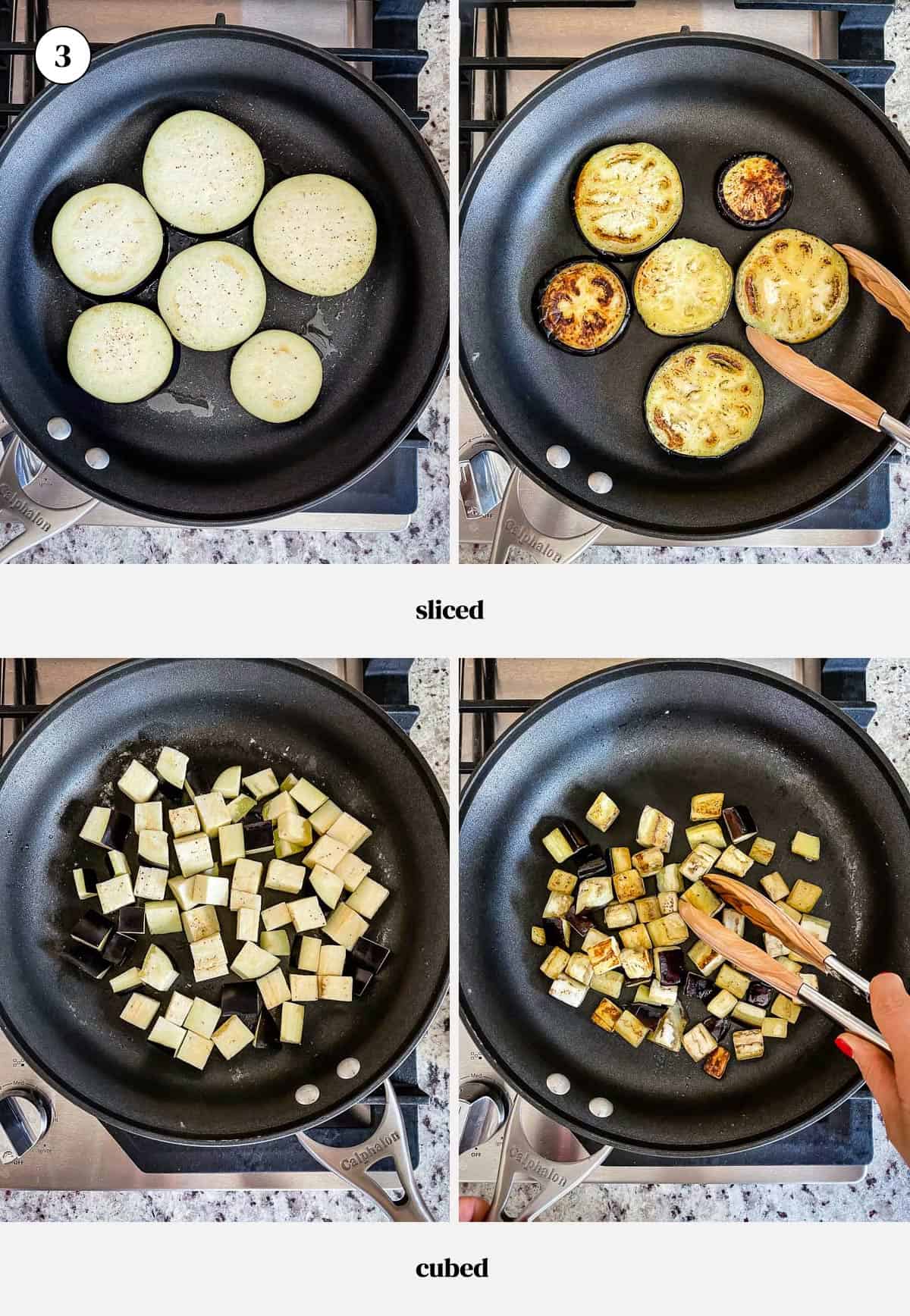
- Saute eggplant: Heat about 2 tablespoons of the oil in a non-stick, large skillet over medium-high heat until it is shimmering hot. Arrange half of the slices in the skillet in a single layer and fry eggplant in olive oil for 5-7 minutes per side or until golden brown and caramelized. If you are cooking cubed eggplant, the cooking time would be a few minutes shorter.
- Repeat: Before cooking the second batch of eggplant slices, pat them dry on both sides with a paper towel (they tend to sweat as they sit). Add two more tablespoons of oil to the skillet and repeat the above process to saute the remaining eggplant slices.
- Garnish and serve: Transfer the caramelized eggplant to a serving plate and garnish with your toppings of choice, such as a sprinkle of parmesan, fresh herbs, and chili flakes.
How to Store, Reheat, & Freeze
I prefer to serve my eggplant stovetop recipe immediately after cooking, but you can always store and reheat your leftovers to enjoy on another day. Sauteed eggplant is also delicious when served cold, especially on sandwiches or salads! Here are some storage and reheating tips:
- Store: Bring your eggplant saute to room temperature before placing it in an airtight container. It will keep in the fridge for 3-5 days.
- Reheat: When it comes to reheating eggplant, you have a few options. I recommend reheating in a 300-degree F air fryer for about 3-5 minutes or in a 350-degree F oven for a few minutes or until warmed through. Alternatively, you can also reheat the eggplant slices in a non-stick skillet until warm. Make sure to keep a close eye on them, as they can burn quickly.
- Freeze: To freeze your pan roasted eggplant, I recommend the flash-freezing method. Bring the slices to room temperature, arrange them in one layer on a parchment-lined baking sheet, and place them in the freezer. Once they are frozen, you can put parchment sheets between each slice to prevent them from sticking together and store them in a freezer-safe plastic bag or sealed container.
Expert Tips
While this healthy eggplant recipe is pretty straightforward, I’ve learned some tips and tricks along the way that helped me achieve golden brown, tender, and sweet eggplant rather than mushy, bland slices. Here’s what you need to know:
- Sliced crosswise vs. diced: How you cut your eggplant will affect the outcome of this recipe. I find that sauteing eggplant slices is easier than cooking diced eggplant, as slices are easier to flip, have more surface area for caramelization, and hold their shape without getting mushy. It’s possible to caramelize your pan fried eggplant cubes, but they tend to get mushy while cooking. To avoid this problem, leave your cubed eggplant alone as much as possible and turn them one by one (gently!) in the skillet. Also, make sure to saute eggplant cubes in one layer to avoid overcrowding. If you need to cook them in batches, add more oil between each batch if there’s not enough excess oil from the previous batch.
- If using diced eggplant, keep the peel on: If you’re cooking diced eggplant to add to various sauteed eggplant recipes, I recommend keeping the peel on. This layer of tougher skin will help them hold their shape while cooking.
- Salting your eggplant: Chefs used to generously salt eggplants before cooking them to remove bitter flavors. This technique is, for the most part, no longer necessary because modern farming has eliminated most of the bitter flavors from the vegetable. If you picked up your eggplant from the farmer’s market or if you grew it yourself, you may need to season it before cooking. To learn more, check out my How to Salt Eggplant guide.
- Cut your eggplant right before using: Once sliced, eggplants oxidize and turn brown very quickly, so make sure to cut your eggplant right before you intend to use it. Alternatively, you can fill a large bowl with tap water and add a few tablespoons of salt and place your cut eggplant slices or cubes to prevent them from changing their color.
- Use a non-stick skillet: Even with the help of oil, eggplant tends to stick to skillets that aren’t non-stick. To successfully pan fry eggplant, you’ll want to use a non-stick saute pan (affiliate link) to ensure even cooking and avoid a mess!
- Don’t overcrowd the skillet: You may be tempted to add all your eggplant slices to the skillet at once, but it’s very important that each slice has room to cook and brown evenly. If you’re cooking eggplant on stovetop in several batches, make sure to add more oil before each batch.
- Use visual cues: Cooking time for your eggplant will depend on the size and thickness of your slices. While it should take about 5-7 minutes per side, you’ll know the eggplant is done when it appears golden brown and caramelized.
- Don’t skimp on garnishes: Eggplant is still delicious with simple seasonings, but you can really elevate the flavor by adding lots of garnishes. I love to top mine with fresh herbs, parmesan cheese, and a sprinkle of chili flakes.
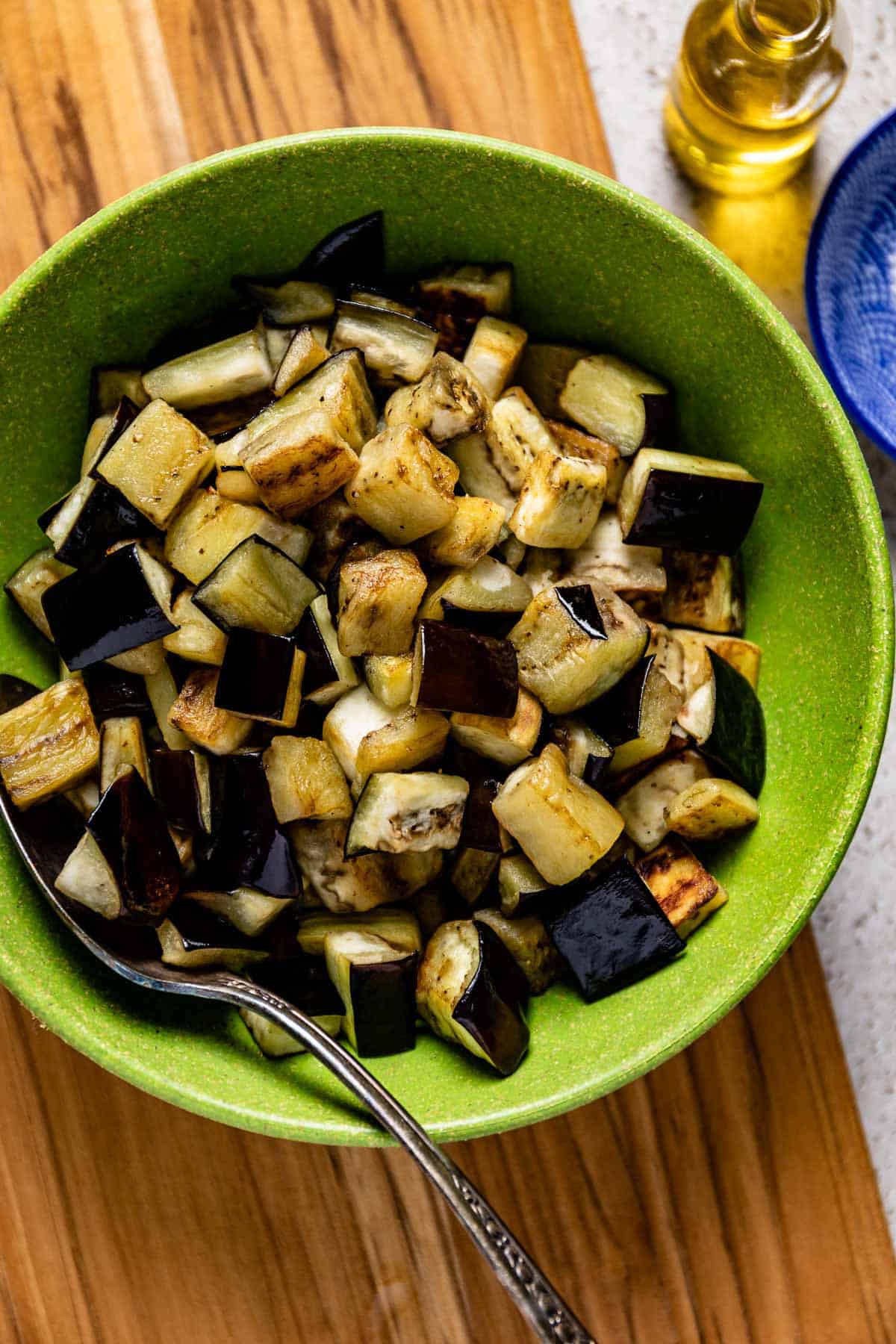
What to Serve with Pan-Fried Eggplant?
Since this eggplant side dish recipe is so simple and versatile, you can pair it with virtually any main you’d like! Feel free to switch up the garnishes and seasonings for your sauteed eggplant to complement the flavor profile of your main dish. Here are a few pairing suggestions:
- Chicken recipes: Chicken and a veggie side dish is a classic combo. Serve your seared eggplant with my juicy Yogurt Marinated Chicken or Air Fried Cornish Hens for a dinner-party-ready spread, or have an Italian night by serving it with Baked Chicken Parm.
- Seafood: For a fresh, light spring or summer meal, serve your eggplant side dish with a flavorful seafood recipe. Fire up your grill on a nice day and make my Grilled Mahi Mahi, Shrimp Scampi, or Shrimp Kabobs.
- Vegetarian: Get creative with your flavor profiles and pair your quick eggplant recipe with a yummy vegetarian main. Top your skillet eggplant with feta cheese for a Mediterranean flair, and serve it with Quinoa Salad with Feta or Quinoa Tabbouleh. Or, sprinkle your eggplant dish with parmesan cheese and pair it with my delicious Italian eggplant recipe, Baked Eggplant Parmesan.
FAQs
There’s no need to peel before cooking eggplant on the stove, as the peel softens during the cooking process. Eggplant skin even contains some nutrients! Leaving the peel on also helps your eggplant slices keep their shape while cooking. You can, however, peel your eggplant with a vegetable peeler if preferred (I recommend peeling it before cutting it into your desired shape).
In the past, salting eggplant was a necessary method to get rid of the vegetable’s bitter taste, but nowadays, modern farming techniques have reduced the bitterness of eggplants. If you bought your eggplant from your local grocery store, you don’t need to salt it, but if you purchased it from a farmer’s market, grew it yourself, or have a big eggplant, salting it before cooking on the stove would not hurt. For additional details, refer to my tutorial on salting eggplant.
If you are cooking eggplant slices, it is best to cook them for 5-7 minutes on each side for a total of 10-14 minutes, whereas if you are sauteeing eggplant cubes, you should cook them 4-5 minutes per side for a total of 10-12 minutes. They should be perfectly sauteed when they turn golden brown.
Other Easy Eggplant Recipes You Might Also Like
If you can’t get enough of this yummy purple veggie after trying this sauteed eggplant recipe (we don’t blame you), then you’ll be glad to know that we have many other easy eggplant recipes here on the blog. Check out the links below for more quick recipes with eggplant:
- Eggplant Rolled with Ricotta
- Vegetarian Stuffed Eggplant
- Breaded Eggplant in Air Fryer
- Eggplant Yogurt Dip
- Panko Crusted Baked Eggplant
If you try this Sautéed Eggplant Recipe or any other recipe on Foolproof Living, please take a minute to rate the recipe and leave a comment below. It helps others who are thinking of making the recipe. And if you took some pictures, be sure to share them on Instagram using #foolproofeats so I can share them on my stories.

Sauteed Eggplant Recipe
Ingredients
- 1 Globe Eggplant, ~1lb – rinsed and dried
- ½ teaspoon kosher salt
- ¼ teaspoon ground black pepper
- 4 tablespoons olive oil, plus more as needed
Optional Garnishes
- 1 tablespoon parmesan cheese
- 1 tablespoon fresh herbs, such as fresh basil leaves or parsley
- 1 Pinch of red pepper flakes, optional
Instructions
- Slice eggplant crosswise in ½-inch-thick rounds*.
- Sprinkle eggplant slices with salt and pepper on both sides.
- Heat half of the oil in a large non-stick skillet over medium heat. Add half of the eggplant slices in a single layer and cook for 6-7 minutes on each side or until it is slightly caramelized and turned golden brown.
- Before sauteing the remaining eggplant slices, pat them dry on both sides with a paper towel, as they tend to sweat as they sit. Repeat the cooking process using the remaining olive oil for the rest of the eggplant.
- Transfer the now-pan-fried eggplant onto a plate and garnish with parmesan cheese, fresh herbs, and chili flakes, if desired.
Notes
- Sauteed eggplant cubes: Alternatively, you can cut your eggplant into 1-inch cubes and pan-sear them in oil following the same recipe. I prefer sauteing diced eggplant if I am using Chinese or Japanese eggplants instead of large globe or Italian eggplants. However, when sauteing diced eggplant, it is important to pay attention to a few things:
- Do not stir them so much: To avoid eggplant cubes becoming mushy, refrain from stirring them excessively while cooking. It’s better to leave them alone and check for doneness by testing a single cube. When one side turns golden brown, turn each cube one by one to ensure even cooking.
- Be aware of the shorter cooking time: They tend to cook quicker than sliced eggplants, so it is best to cook them for 4-5 minutes on each side (a total of 10 minutes or so).
- Do not crowd the pan: Depending on the size of your eggplant, saute diced eggplant in two batches making sure to cook them on a single layer using more oil as needed.
- Keep the skin on: When pan-frying eggplant cubes, I prefer not to peel the eggplant as leaving the skin on helps keep their shape.
- Store: Bring the sauteed eggplant to room temperature before placing it in an airtight container. It will keep in the fridge for 3-5 days.
- Reheat: When it comes to reheating eggplant, you have a few options. I recommend reheating in a 300-degree F air fryer for about 3-5 minutes or in a 350-degree F oven for a few minutes or until warmed through. Alternatively, you can also reheat the eggplant slices in a non-stick skillet until warm. Keep a close eye on them, as they can burn quickly.
- Freeze: Bring the sauteed eggplant slices to room temperature, arrange them in one layer on a parchment-lined baking sheet, and place them in the freezer. Once they are frozen, you can put parchment sheets between each slice to prevent them from sticking together and store them in a freezer-safe plastic bag or sealed container.
Nutrition
Nutrition information is automatically calculated, so should only be used as an approximation.
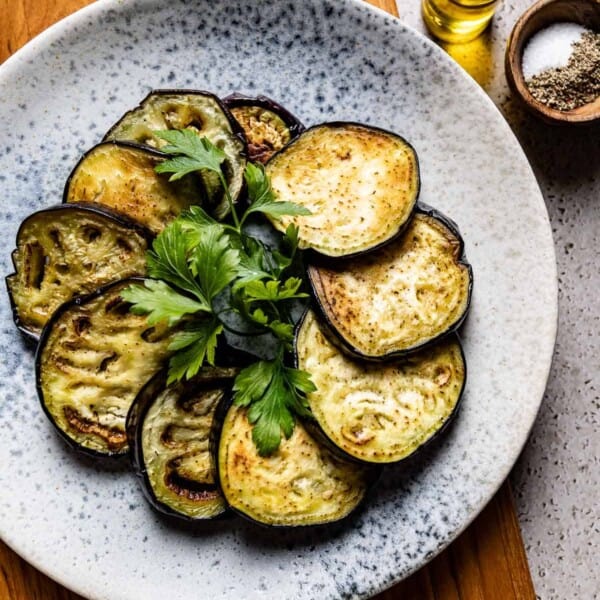

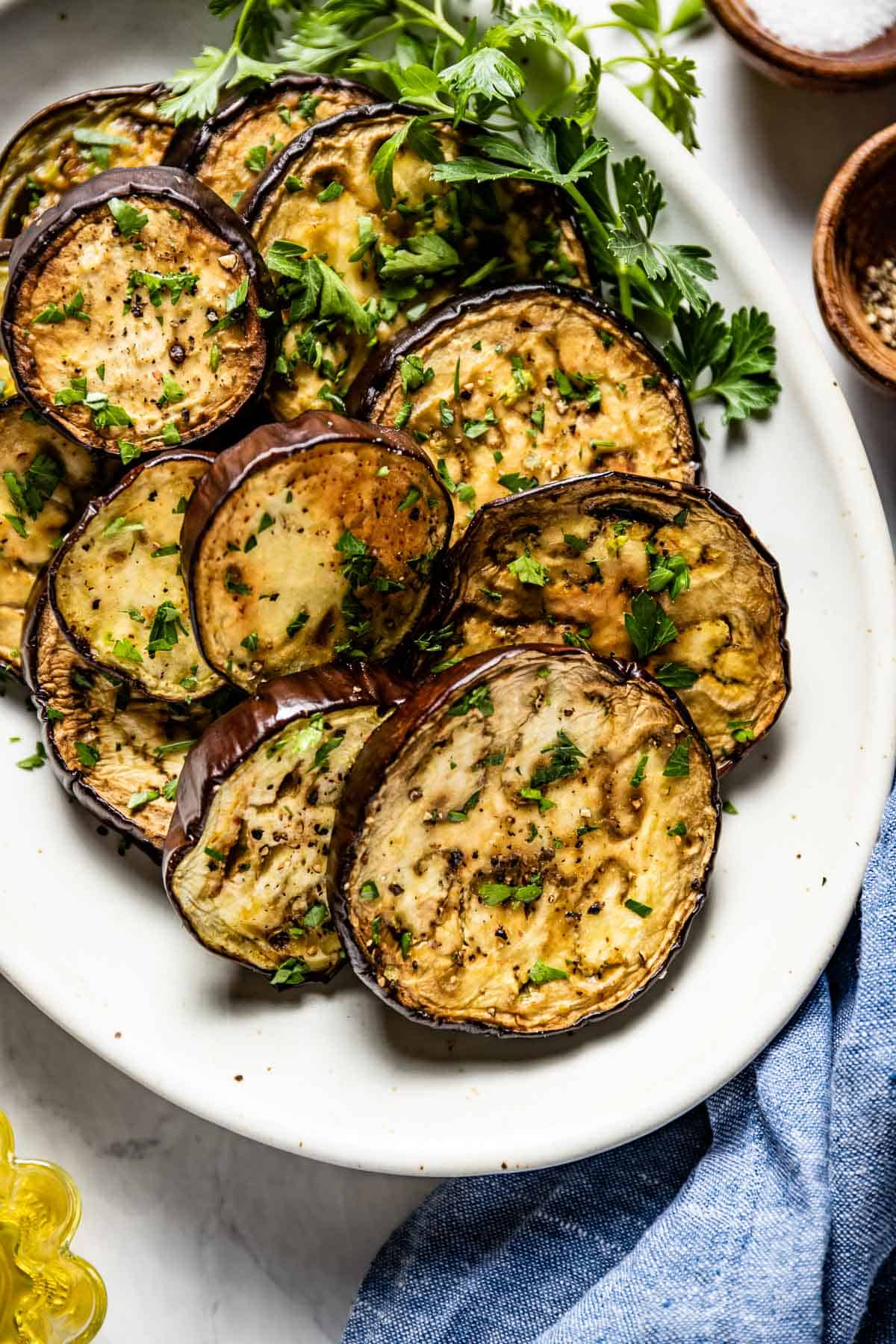
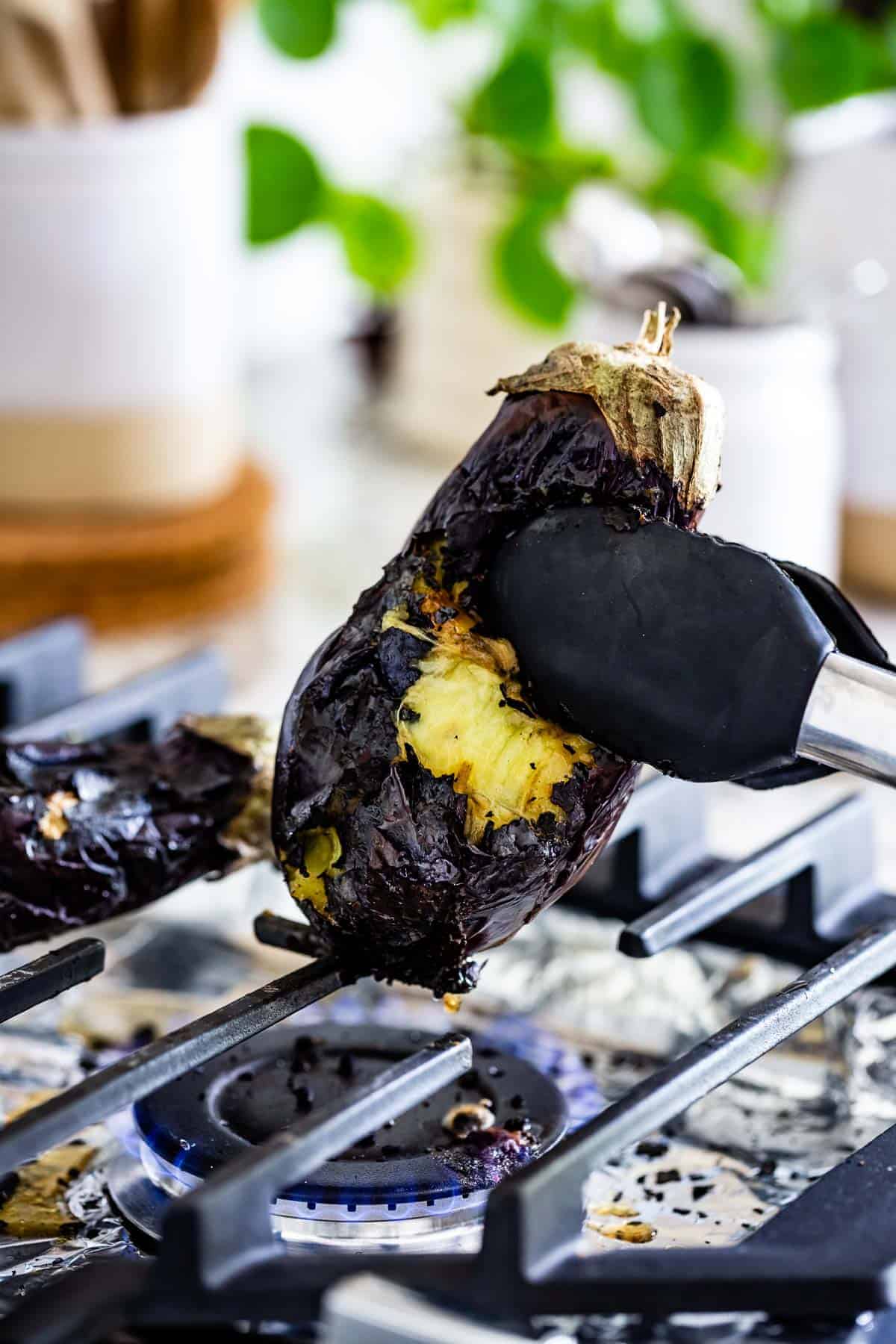
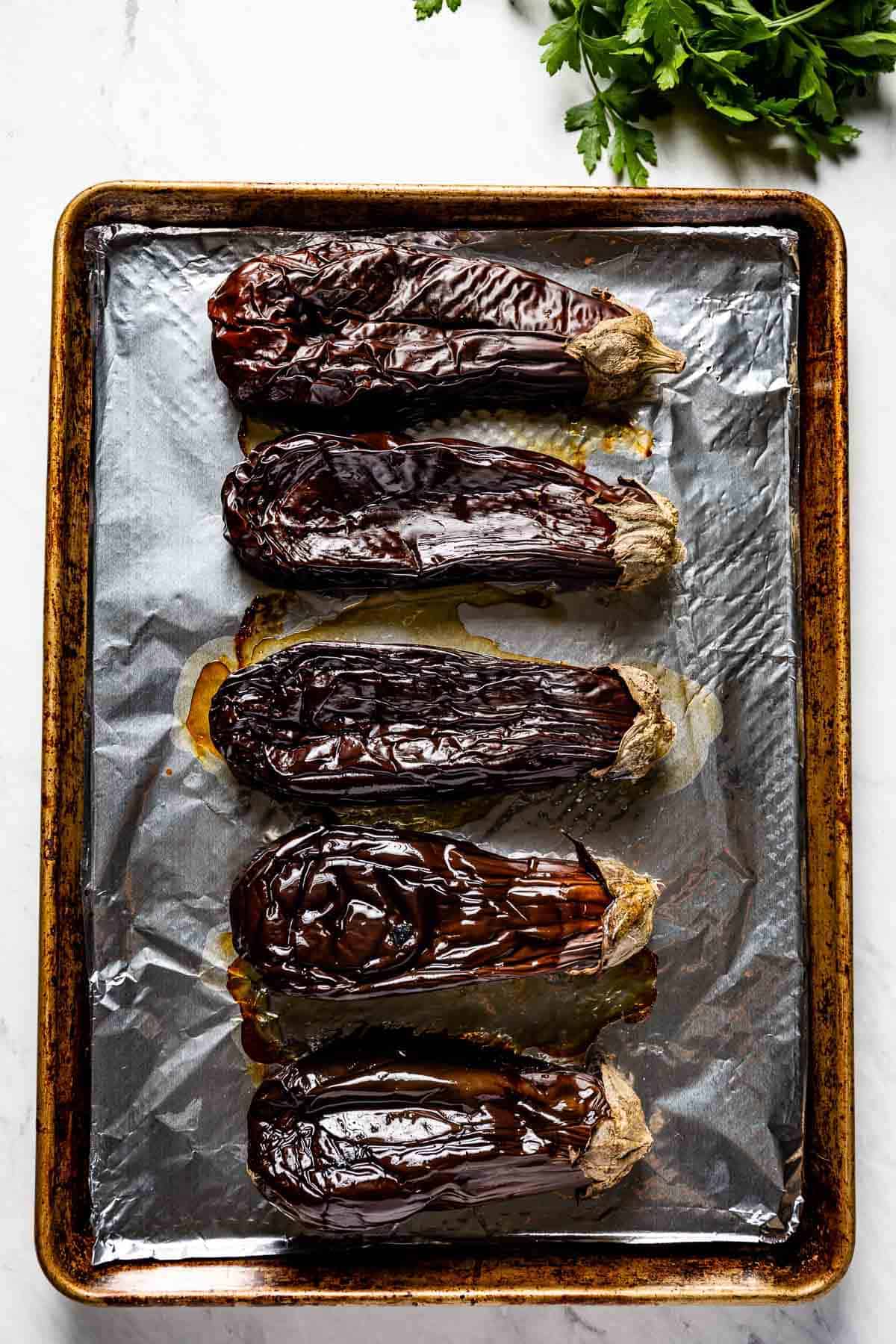
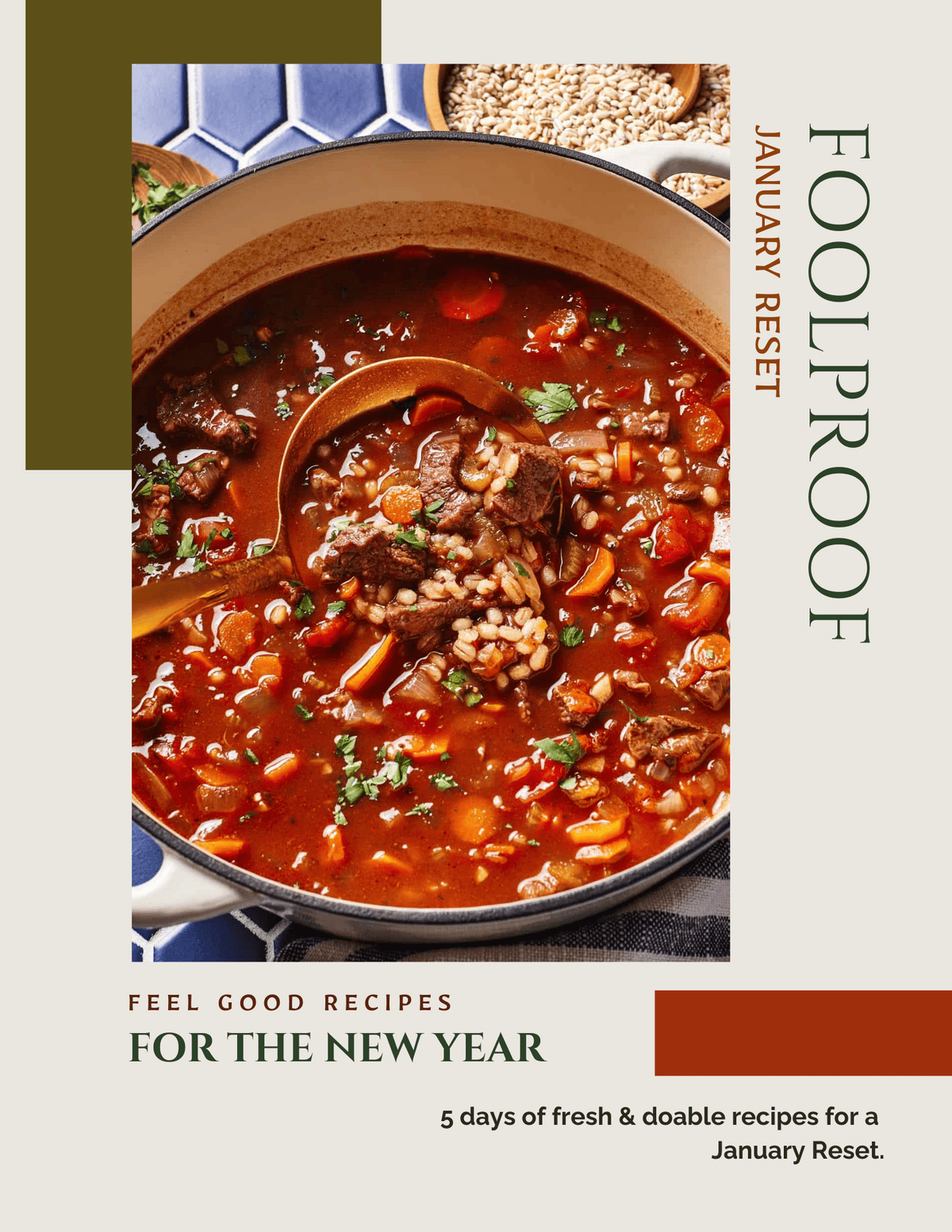









Nice, simple, tasty! The way it should be.
I am happy to hear that you enjoyed this recipe Kevin. Thanks for coming by and taking the time to leave a review.
Best,
Aysegul
This recipe takes eggplants to another level!!! Step by step instructions makes it simple, oops, fool proof. Most importantly is the taste. I have a new appreciation for this healthy and delicious vegetable.
I am thrilled to hear that you liked it DS. Thanks for coming by and taking the time to leave a review.